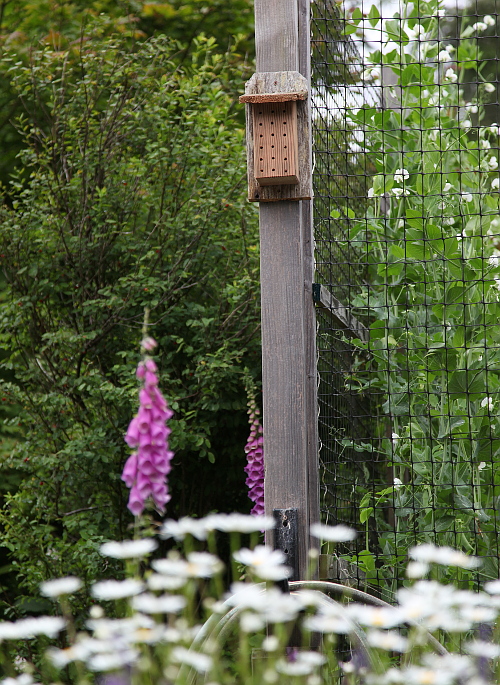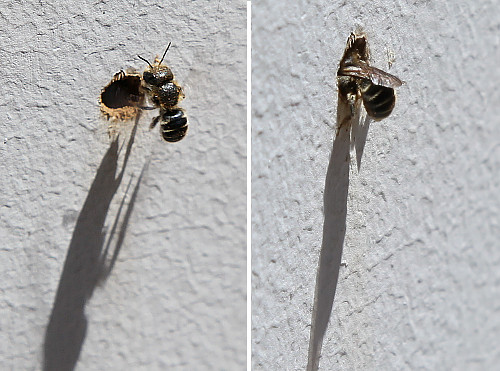I have a fun, simple project for you this week, and it will most likely cost you nothing, take you just a few minutes to make and will create habitat for garden pollinators. It’s also an enjoyable way to observe nature at work. With a little pile of scrap wood we made a few mason bee houses for our garden and yard, and a couple to give as gifts as well.
Mason bees are small, cute, oblong, fuzzy little bees that make efficient pollinators in the garden. They can be blue-green, or dark-colored like the one pictured above. This little lady is not the first to make a nest in this hole in our unfinished door frame.
The female mason bee gathers nectar and pollen and stashes it in the back of the hole until there is a sufficient food store for her young. Once there is enough food to supply the larvae, she lays an egg on the food store and then seals the egg in with a bit of mud. She then brings in more pollen and nectar in front of the previous mud layer, lays another egg, covers it with more mud, and stacks like so until the cavity is full. Once the cavity is full, she seals the hole with a final layer of mud. Maybe you have seen these mud filled holes and wondered what was in there.
Here is a link to more information on mason bees, if you are interested in learning more – http://gardening.wsu.edu/library/inse006/inse006.htm. I think these little bees are pretty fascinating!
We have an endless supply of scrap wood from our various home projects and are always looking for functional ways to use it up. We cleaned up some sections of 4×4, cut an angle at the top to accommodate a little sloped roof, and then drilled 1/4 inch diameter holes in the outer rows and 3/16″ holes down the center. We used all the depth we had in this case, and drilled almost to the back of the 4×4. Typically, larger diameter holes are recommended (5/16″), but maybe our bees here on the coast are pretty small, or maybe they actually prefer smaller than the recommendation. The hole in the door frame is about 1/8″ in diamter, for example.
We used sections of old fence pickets for the roof (not totally necessary, but shelter from rain is nice, right?) and as a backing to make mounting it easy.
Apparently, it is best to hang the house facing east or southeast, for morning sun. The face of that door frame above is pretty much dead south, so a little variation from that recommendation probably won’t break the deal.
I’m looking forward to observing these bees more closely. We really enjoy creating habitat for beneficial species of all kinds at our place.
How do you invite beneficial insects to your garden?





lusciousgreenbalcony
I really like your blog. I like the little bee houses you’ve made and love your garden!